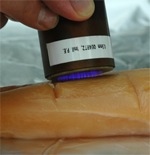
Cold plasma can kill foodborne pathogens: study
By Food in Canada staff
Business Operations Food Safety Research & DevelopmentA U.S. study has found that using a zap of cold plasma on raw meats and poultry can help kill harmful bacteria
Philadelphia, Pa. – Food safety researchers at Drexel University say they may have found an effective method for killing harmful bacteria on raw meat and poultry.
The researchers say plasma can be used to treat raw meat and poultry products before they reach consumers’ homes and can then also reduce the risk of cross contamination during food preparation.
“If you could reduce contamination on the raw chicken, then you wouldn’t have it in the kitchen,” says Dr. Jennifer Quinlan, the senior author of the study.
The study, says the university’s website, was published in the January issue of the Journal of Food Protection.
Harmful bacteria
The bacteria responsible for most foodborne illnesses are Campylobacter and Salmonella, which were found on upwards of 70 per cent of the chicken meat the researchers tested.
Past studies have shown that plasma could successfully reduce pathogens on the surface of fruits and vegetables without cooking them.

Researchers used a probe to create a dielectric barrier discharge plasma and applied it to raw chicken. Image from the Drexel University website.
In the Drexel study, raw chicken samples contaminated with Salmonella enterica and Campylobacter jejuni bacteria were treated with plasma for varying periods of time.
Plasma treatment eliminated or nearly eliminated bacteria in low levels from skinless chicken breast and chicken skin, and significantly reduced the level of bacteria when contamination levels were high.
The researchers also tested using plasma to treat samples of bacteria grown on agar, and demonstrated that antibiotic-resistant strains of bacteria were as susceptible to plasma as the wild-type strains.
Plasma
Plasma, known as the “fourth state of matter” (after solid, liquid and gas), is a high-energy, charged mixture of gaseous atoms, ions and electrons. Plasma has a wide range of potential applications including energy production and control, biomedical treatments and environmental remediation.
Quinlan described the plasma treatment of poultry in this study as “proof of concept.” Current plasma technology is expensive relative to the narrow cost margins involved in food production, and the technology is not currently being developed for processing poultry on a large scale.
If plasma technology becomes cost-effective for use in treating poultry, it may be used in conjunction with existing methods to reduce pathogens, says Brian Dirks, a lead author of the study. It may also help prolong the shelf life of raw chicken if it can be honed to remove more microorganisms responsible for spoilage.
Print this page